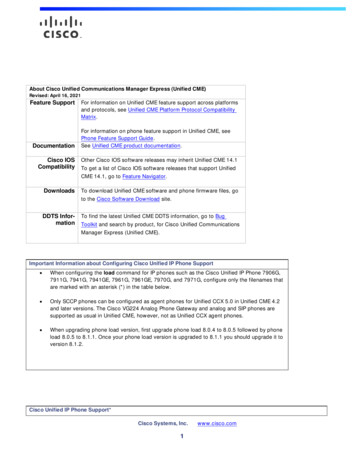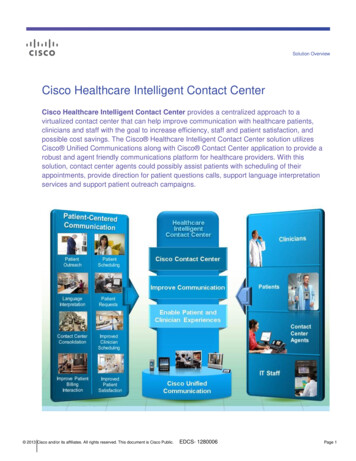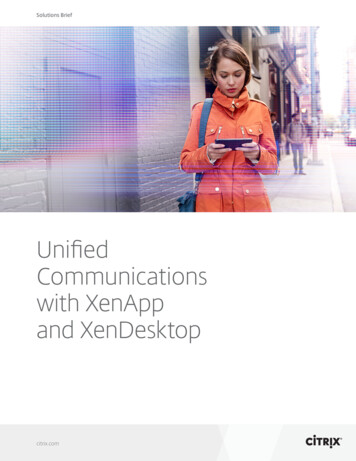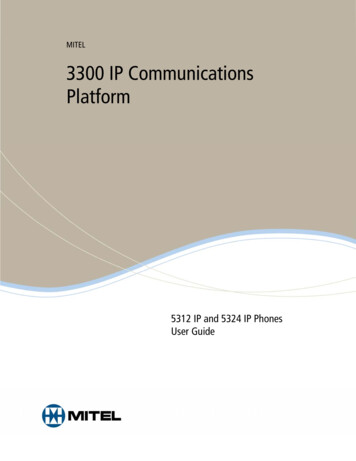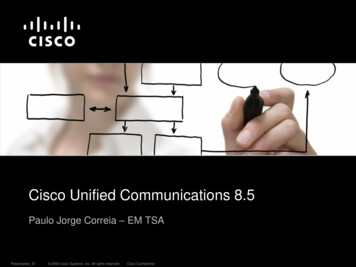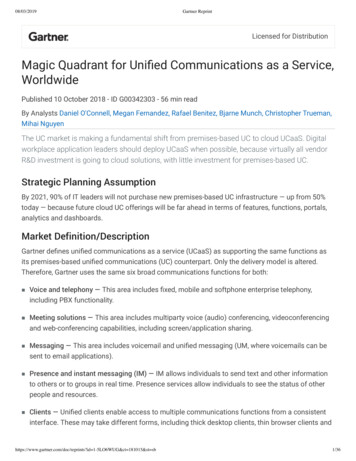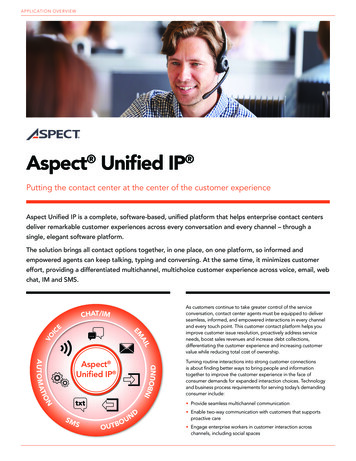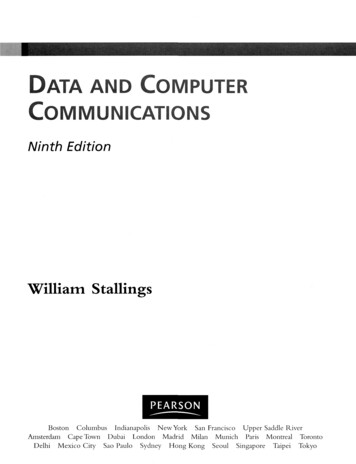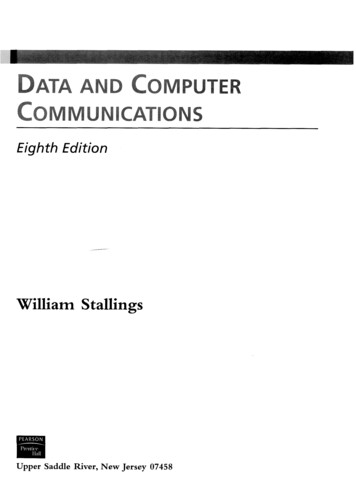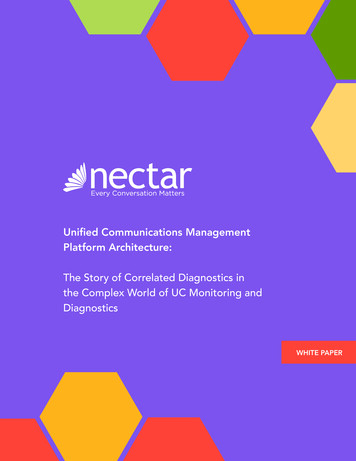
Transcription
Unified Communications ManagementPlatform Architecture:The Story of Correlated Diagnostics inthe Complex World of UC Monitoring andDiagnosticsWHITE PAPER
Table of Contents4The Promise of Unified Communications 4The Value of UC 4The Challenges of UC 4Managing a UC Deployment 4The Reality of Managing a UC Deployment 5The 3 Domains of a UC Deployment Partnering to Optimize the Enterprise’s UC User Experience The “Powered by Nectar” Advantage 778Correlating Diagnostics – Nectar’s UCMP 8Modular 9Scalable 9Multi-Tenant 9Cross-Platform 10UCMP Elements Overview 10UC Foundation (UCF) 10Perspective 10UC Diagnostics (UCD) 10Intelli-Q 11Application Health – UC Foundation 11UCF Value Drivers 11UCF Functionality 13UCF Architecture 14Network Readiness - Perspective 15Perspective Use Cases 16Perspective Functionality 17Perspective Architecture Network Health – Real-Time Quality with UC Diagnostics UCD Value Drivers 181919UCD Functionality 20UCD Diagnostics Architecture 21UCD – The Case for Probes 22End User Health - Advanced Analytics 22Advanced Analytics Value Drivers 23Advanced Analytics Functionality 2Nectar Services Corp. Copyright 2017. All rights reserved.
23Powering The UC Service Provider Practice Intelli-Q – Fitting into the Service Provider Processes 2324Architected for the Service Provider 24UCMP and the Service Provider Value Proposition 24Service throughout the UC life cycle 25Offering Various Levels of Service 25In the Clouds 27Summary 27About Nectar Services Corp. 3Nectar Services Corp. Copyright 2017. All rights reserved.
contention of network bandwidth-intensive solutions, theThe Promise of UnifiedCommunicationsvariabilty of Bring Your Own Device (BYOD), the latencyand load of layered security, and the complexity of cloudand hybrid-deplyoyed solutions. Most UC managementThe Value of UCofferings today cannot pinpoint the exact problem, norcan they deliver real-time monitoring to provide theWhen the term “unified communications” (UC) enteredconsistent, reliable collaboration infrastructure that mostthe enterprise IT lexicon in the mid-1990s, it broughtenterprises require.the promise of increased business productivity throughenhanced collaboration and individual employeeManaging a UC Deploymentefficiency. The potential value of UC is in drivingoperational efficiencies by removing the “friction” in theMost analysts note that UC best practices for users andway individuals, groups, and companies interact andperform.system integrators are still maturing. With regard toFrom an architecture perspective, UC encompassesservice providers and enterprise IT staff must be able toemerging UC services, Frost & Sullivan suggests thatmanage and monitor the applications, servers, endpoints,a suite of products that provides a consistent userand network infrastructure that drive the way today’s workexperience across multiple devices and media types.gets done in order to ensure an optimal user experience.UC solutions may consist of individual products or suitesTo effectively do this, an enterprise needs to leverage thefrom a single vendor or, more commonly, a portfolio ofright tools.integrated applications and platforms that span multiplevendors. In many cases, UC technology is deployed toThe Reality of Managing a UCDeploymentextend and add functionality to a company’s establishedcommunications investments.The Challenges of UCGartner has found that many network teams are ill-Although UC offers the promise of increased uservaried issues with which most enterprise businessesproductivity, business agility, and effective control ofcontinue to struggle. Gartner further notes in itsoperational costs, companies continue to face difficultOctober 2016 Market Guide for Unified Communicationschoices in terms of implementation and migrationMonitoring that:equipped to manage, troubleshoot and diagnose thestrategies, as well as how to effectively manage the more complex environment of a UC deployment.Real-time voice and video are the most networksensitive applications. When network performanceApplications like conferencing, mobility, video, andis challenged by congestion, these typically breakcollaboration have massive performance and availabilityfirst.requirements that often fail to meet the high expectationsof users. Delivering on these expectations becomesan even more onerous goal in today’s world with the4Nectar Services Corp. Copyright 2017. All rights reserved.
Troubleshooting complex UC solutions requires a combination of vendor-derived, end-user, protocol-servers process codecs or register/users calls?and packet-based data sources for in-depth understanding and diagnosis of issues. Does high CPU utilization negatively affect how theIs low disk space slowing down processing time orjeopardizing the retention of key records?Migrating between legacy and new UC platforms often involves changing network and serviceDid someone accidently let certificates expire, thusbringing the entire UC deployment down?providers. This results in bifurcated unifiedNetwork Domaincommunications monitoring (UCM) requirements.One of the advantages of UC is that it converts voice,The 3 Domains of a UC Deploymentvideo, and other communications into packets that canrun across the existing data infrastructure. One of theThe flip side of UC’s promise of user enablement and anchallenges of UC is that real time communications is highenhanced user experience is the added complexity ofbandwidth and extremely time sensitive, which means ittrying to monitor and troubleshoot across a much moreis highly dependent on an efficient network, while at thecomplex environment. Gone are the days of a phonesame time adding a heavy burden to that same network.connected via a dedicated wire to circuit pack in a PBXAny congestion on the network or configuration driftcabinet. Troubleshooting today’s UC conversations meanscould impact how real-time communications traffic istrying to correlate across 3 different domains.transported over the data network and could negativelyimpact the user experience.When evaluating the potential impact of the networkdomain on the health of a UC deployment, here are somekey questions to consider: Is the network properly architected to supportexpected UC traffic? Application DomainIs the network configured to properly prioritize UCtraffic? With the adoption of UC, every communications platformIf there are call quality issues, was the network afactor?has become a server running software. The application domain is the UC software itself and the servers andIf the network was a factor, which networksegment(s) created the issue?services that host this software. If the servers and platform software are not running optimally, the user experienceIf the network was a factor, what happened in thenetwork to create the issue?could suffer. If the network was a factor, what other users/callsmay have been impacted by the same issue?When evaluating the potential impact of the applicationdomain on the health of a UC deployment, here are somekey questions to consider:5Nectar Services Corp. Copyright 2017. All rights reserved.
End User Domainthese functions is distinct and brings unique value to theEven if the platform is running optimally and the dataongoing optimization of the UC deployment.network is transferring communications packets in themost efficient way, the end user can still heavily influenceMonitoringtheir own user experience. The connectivity to theIn the world of UC optimization, monitoring is thenetwork (wired, WiFi, mobile), the device itself (hardongoing observation of the UC environment over a periodphone, PC, tablet, mobile, etc.) and even the headset/of time. It is a systematic review of the health of the UCspeakerphone will impact the experience of the user andinfrastructure and components. When monitoring theeveryone they communicate with. The end user domainhealth of various system components (servers, etc.), UChas the unique position of being the area with both themonitoring tools will capture, report, and alert on relevantmost variability and the least control by the IT staff.performance metrics, sometimes called key healthindicators (KHI’s).When evaluating the potential impact of the end userdomain on the health of a UC deployment, here are someReportingkey questions to consider:While monitoring is more ongoing in nature, reporting Is the user on a wired or wireless connection? Is the user using a supported-device (headset,is a historical analysis of the UC environment. Througheffective reporting, enterprises or their service providerscan begin to track patterns over time. Sometimes thesespeakerphone, etc.)? patterns highlight usage adoption, both positive andIs there a consistent pattern of poor usernegative. These patterns can also illuminate issues withinexperiences based on device (manufacturer, OS,the end user domain mentioned above. Reporting canclient, etc.), headset or wireless SSID; with a singlealso create snapshots of monitoring output to analyzeuser or across a group of users?potential patterns with service levels and performancemetrics over time.Correlated DiagnosticsSo, when there is a poor user experience, was it causedDiagnosticsby the application? The network? The end user’sDiagnostics is the practice of identifying the root causeenvironment? How do you know? What if it was a littleof poor user experiences by an examination of theof each? Nectar’s UCMP offers correlated diagnostics that“symptoms” and the environment during the time spanallows service providers to see the conversation across allof the call or in real time. Diagnostics allows service3 domains and efficiently troubleshoot any issues.providers to investigate specific user sessions and withinthe context of what was actually going on in the networkThe 3 Functions of Managing to An Optimal UC User(media and signaling) at the time of that call, potentiallyExperienceeven as the call is happening. Diagnostics can also helpIn an effort to simplify the complexities of managing a UCilluminate specific network segments that are negativelyenvironment, many tools providers and services providersimpacting UC conversations.combine monitoring, reporting, and diagnostics intoa single “monitoring” label. The reality is that each of6Nectar Services Corp. Copyright 2017. All rights reserved.
Partnering to Optimize theEnterprise’s UC User Experiencemanage a UC deployment. Based on their experienceRelying on a Service Providerthe UC user experience of their clients. They have alsoand expertise, service providers have evaluated themarket and determined the best tools for optimizinginvested in the training to understand how to best utilizeGiven the complexities of effectively managing a UCthose tools. Since they are leveraging the tool acrossdeployment, most enterprises look for a service providermultiple enterprise clients, they are using the tools dailythey can trust to monitor, diagnose and remediate theirand therefore their training remains current and fresh.UC environment. The exceptional service providers areable to demonstrate their value by providing effectiveServices “Powered by Nectar”reports on the health of the UC environment, the workNectar is the industry leader in tools for monitoring,they have done to optimize the health, and the usage andadoption that the UC deployment has achieved.diagnostics, and reporting on UC deployments. Nectar’sSince UC is their core competency, service providersto optimize their ability to handle the UC managementtools were built to be leveraged by service providersrequirements of their enterprise clients. Services poweredhave both the breadth and depth of personnel toby Nectar are a clear competitive differentiator whenhelp enterprises with their UC deployment. Mostenterprises are selecting the service provider to care forenterprises don’t have the IT staff to effectively managetheir UC deployment.a UC deployment across all 3 domains 24 hours perday, 7 days per week, especially if their users spaninternal staff on each underlying component of theThe “Powered by Nectar”AdvantageUC infrastructure. The focus of a service provider onUC is a valuable tool for driving enterprise productivityglobal geographies. Even if the enterprise did havethe headcount, it is expensive to invest in training theirUC management justifies the investment in a staff withby facilitating collaboration across the enterprise. Theenough people to support all of the users of all of theirdistributed and flexible deployment options for UC makeclients as well as the individual expertise to go deep in theit complex to architect, deploy, manage, and maintain.troubleshooting and remediation of a variety of specificcomponents.Enterprises who want to maximize their UC investmentand optimize their user experience need to select aService providers have also developed an effectiveservice provider with the people, processes, and tools toprocess for maintaining and managing an enterprise’s UCmonitor, diagnose, and report on their UC deployment.deployment. Since their entire business value is based oneffectively and efficiently monitoring and troubleshootingNectar agrees. This is why our company has devotedpotential UC issues, they provide this service at a costits considerable years of experience and expertisemost enterprises could not match internally.to the development of a real-time, vendor-agnosticcommunications management architecture that takesIn addition to the people and the processes, servicea holistic approach to providing inventory, monitoring,providers have the tools to effectively maintain and7Nectar Services Corp. Copyright 2017. All rights reserved.
alarm, root-cause-analysis, capacity, and performancemanagement while enabling remediation for real timecommunications systems.Nectar’s holistic approach to UC monitoring andCorrelating Diagnostics – Nectar’sUCMPdiagnostics is specifically designed to provide completevisibility throughout a multi-vendor UC environment viaa ‘single-pane of glass’, multi-site, multi-location viewNectar UCMP is a modular, scalable, multi-tenant, cross-that can support hundreds of thousands of end usersplatform UC management/diagnostics suite architectedworldwide. Because the UCMP architecture is designedfrom the ground up to offer service providers theto be vendor- and technology-agnostic, it enables servicecorrelated diagnostics they need to optimize the UCproviders to deliver significant economies of scale to theiruser experience for their clients. UCMP provides theclient’s deployments while assuring an easy path for futureability to maintain a complete, centralized, multi-vendortechnology needs and business growth. This agnosticUC environment with a single tool. It also allows serviceapproach enables Nectar to deliver real-time visibility intoproviders to quickly adapt to their customers’ changingthe quality of each UC user’s experience, regardless ofUC environments, effectively manage complexity, andvendor platform or network configuration – on-premises,maximize their total cost of ownership.cloud-based, or hybrid.At its core, the Nectar UCMP architecture deliversThis whitepaper will identify how Nectar’s Unifiedexceptional system health and availability with a singleCommunications Management Platform (UCMP) enables360-degree view of all voice and data assets. Pre andservice providers to effectively deliver services whereinongoing network assessment and UC monitoring is madetheir highly trained staffs can work across a multitudepossible via infrastructure auto-discovery, a multi-tenantof systems centrally, gaining economies of scale andNOC interface, root cause analysis, contextual monitoring,collaboration amongst multiple, diverse engineeringand at-a-glance troubleshooting. The Nectar architecturedepartments. Available in both SaaS (operating expense)provides for enhanced performance by focusing on theand traditional software purchase (capital expense)entire UC ecosystem via integrated capabilities such asbusiness models, the UCMP solution is engineered toresource trending and utilization, capacity monitoring andoperate in distributed, large, overlapping IP addressplanning, and comprehensive reporting and analytics.environments, pass information through firewalls via asingle encrypted connection, and scale both inside aModularcustomer’s large global enterprise, as well as externally forservice provider installations.Nectar’s UCMP leverages 5 different modules to createa correlated tool to help service providers optimize theapplication, network, and end user domains of the UCdeployment. The modular structure of UCMP grantsservice providers flexibility in how they incorporate Nectarinto their service offerings. The service provider can8Nectar Services Corp. Copyright 2017. All rights reserved.
leverage different combinations of modules based on theUC platforms (Avaya, Cisco, and Microsoft Skype forneeds of each enterprise client environment and/or or theBusiness). Nectar also has VKM’s for Sonus gatewayslevel of service the enterprise client wants to purchaseand slightly less automated collections packs for a varietyfrom the service provider. We will discuss the variousof infrastructure vendors within the UC ecosystem. Themodules and their impact on the specific UC domainsability to poll for SNMP strings and receive SNMP trapsthroughout this whitepaper.extends Nectar’s reach to nearly any component in aUC deployment. Nectar’s ability to provide monitoringScalableand diagnostics across multiple platforms means thatUCMP is not only modular in terms of the softwareBusiness environments and their supporting ecosystemscomponents that can be activated, but the overallwith a single tool. This expands the market for thosearchitecture is modular, which makes a Nectar deploymentservice providers, including those enterprises with avery scalable, both within a specific enterprise client andvariety of platforms within their environment.service providers can support Cisco, Avaya, and Skype foracross the entire customer base of a service provider.This scalability means that Nectar can grow with theThrough this type of unified, architecture-basedservice provider and their clients. Scalability is also a keyintegration, the UCMP solution enables service providersconsideration as some service providers look to bring ato quickly identify, isolate, and remediate UC performancehosted UC as a Service (UCaaS) offer to market. Nectarissues while controlling costs. Regardless of the type ofscales to provide monitoring, diagnostics, and reportingmulti-vendor enterprise UC environment – on-premises,to a large, multi-tenant hosted deployment.hybrid, or cloud-based – the Nectar UCMP solution cansupport each customer’s unique business needs with aMulti-Tenantvariety of customizable software modules and servicesFrom its inception, Nectar developed a software platformUC system resources.that ensure peak performance and optimum utilization ofthat was purpose-built for service providers. For anyservice provider with more than one client, multi-tenancyNectar enables simple access to voice quality metricsbecomes critical. UCMP was designed to allow servicethat include trace route and IP network visibility, real-timeproviders to monitor and manage their entire portfolio ofmedia analysis, and immediate UC network awareness.enterprise clients with a single pane of glass. The dataFurther, comprehensive troubleshooting tools enableof each client is insulated for security and privacy, whilesynthetic call testing, remote access and call tracing, filealerts and alarms and presented in a centralized view sotransfer and secure chat capabilities, alarm management,the service provider NOC can effectively and efficientlyand SLA tracking and management.prioritize and track all issues.Cross-PlatformOver the years, Nectar has developed pre-definedcollections/alerting packs known as Vendor KnowledgeModules (VKM’s). Nectar
Unified Communications Management Platform Architecture: The Story of Correlated Diagnostics in the Complex World of UC Monitoring and Diagnostics WHITE PAPER. . End User Health - Advanced Analytics 22 Advanced Analytics Value Drivers

